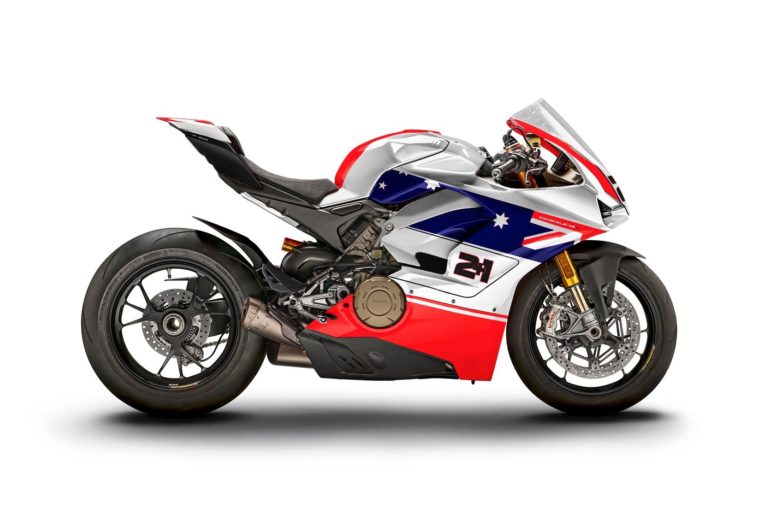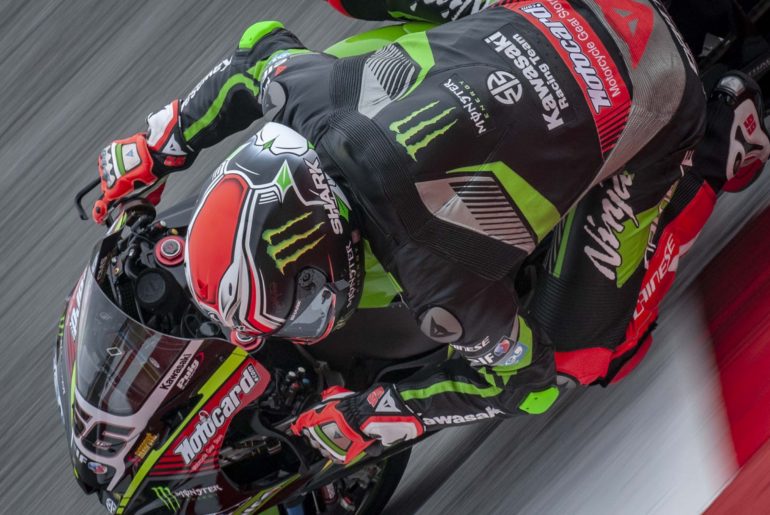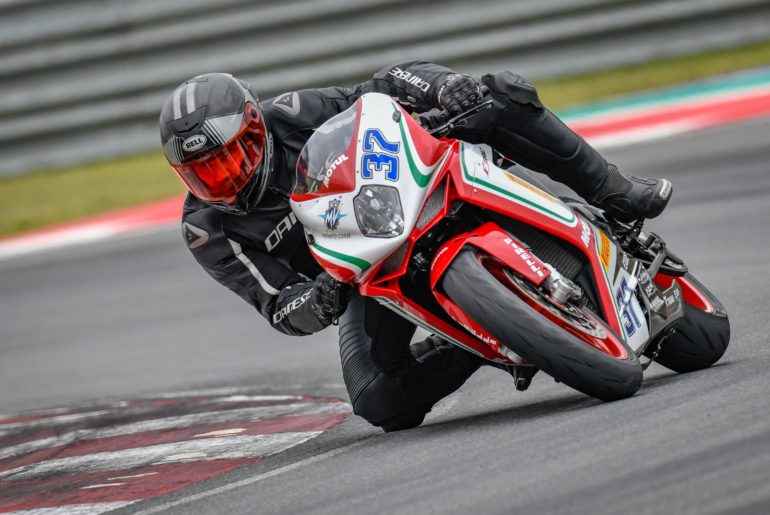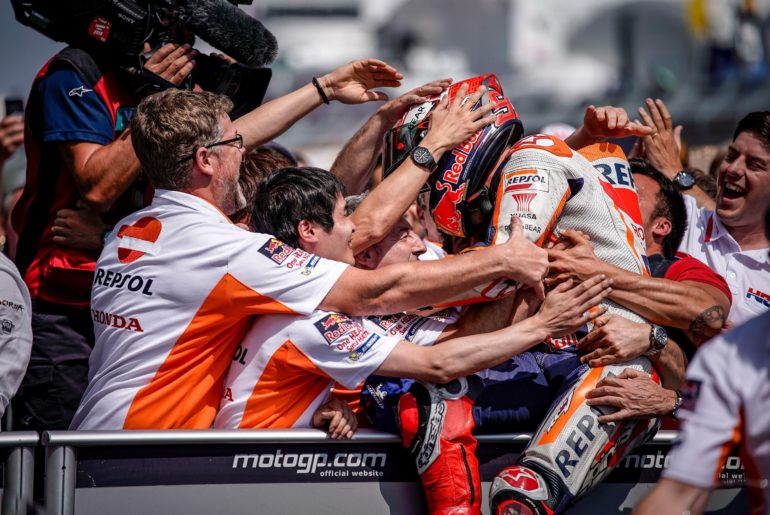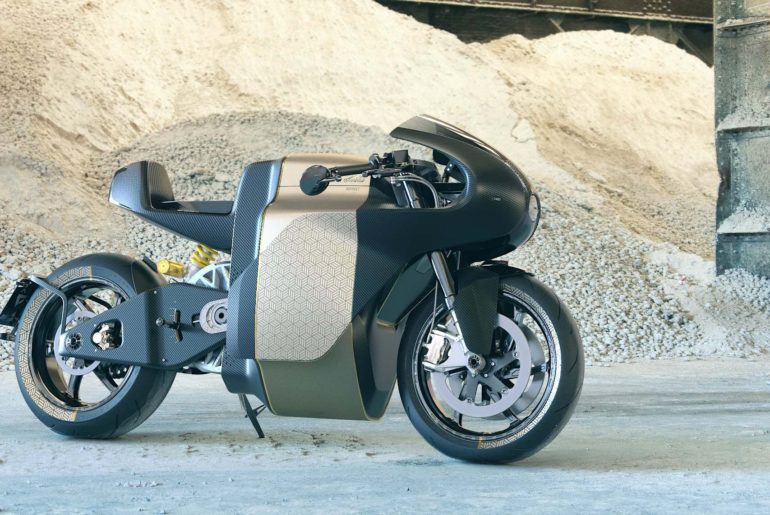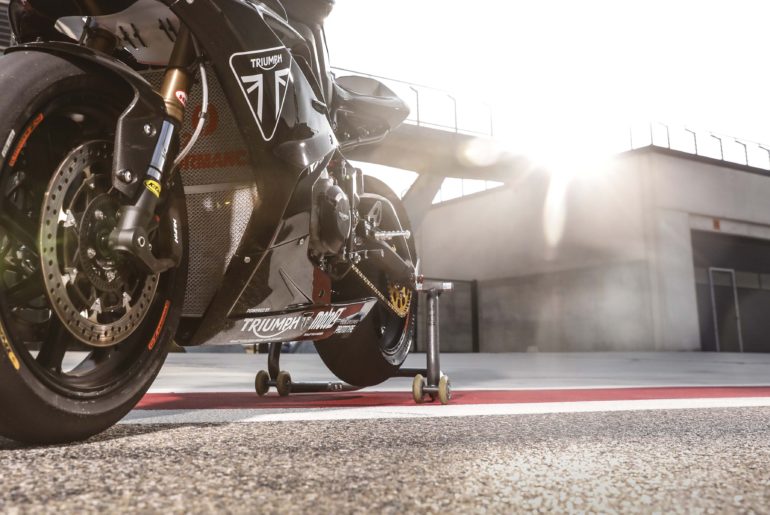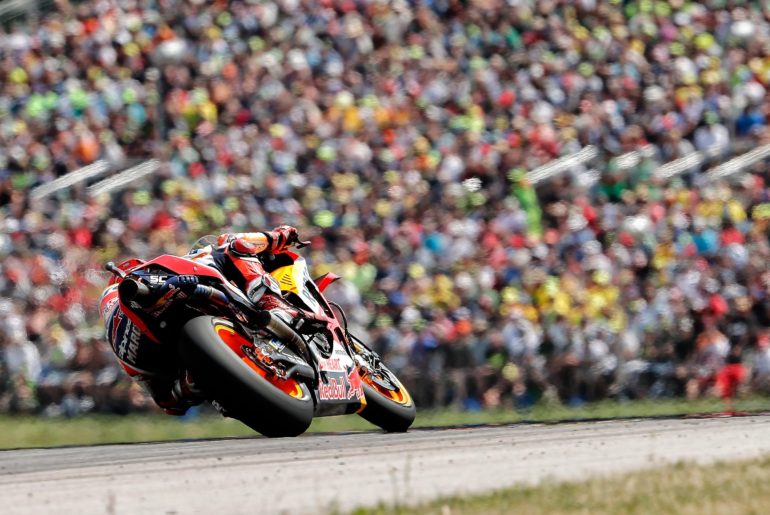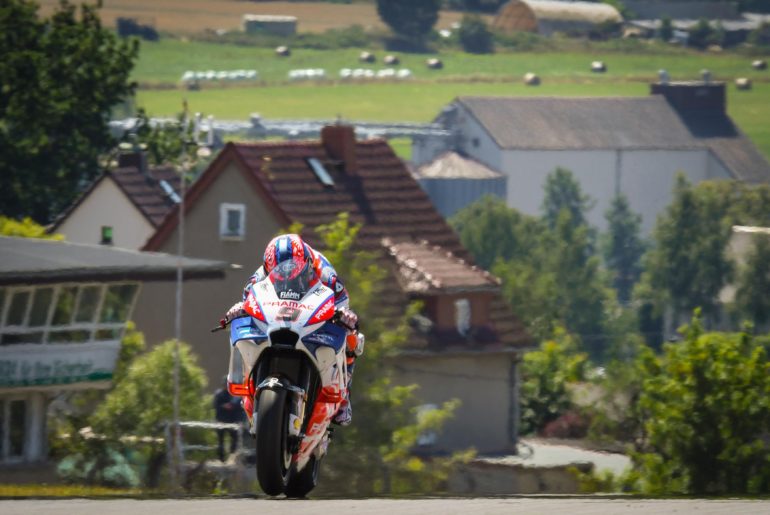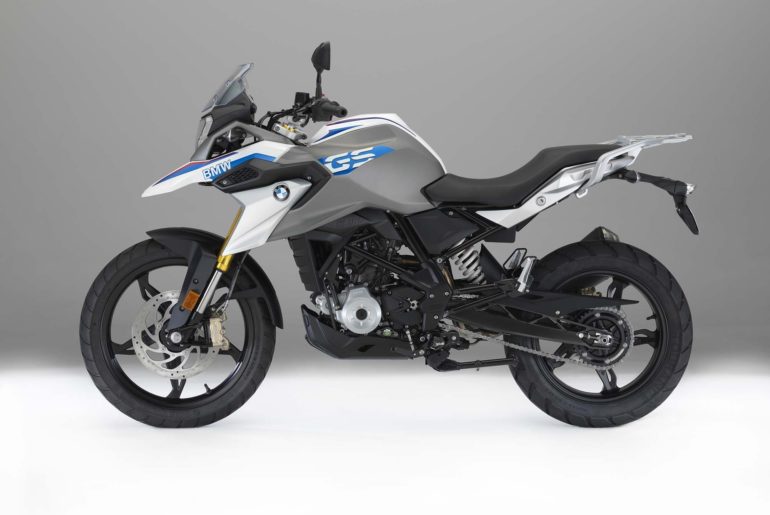It is a truism in MotoGP that though they hand out the trophies on Sunday, the race is often won on Friday and Saturday. Practice is when riders and teams can find the setup tweaks they need to go faster, evaluate tire choices, and plan a strategy.
Which tires offer the most potential? Which area of the track can we gain most while sacrificing the least in other points? Is there more to be gained by pushing hard early and trying to manage, or by being patient in the first half of the race, hoping to have an advantage in the second half?
The wide range of tires offered by Michelin make practice even more important. Michelin’s remit from Dorna is to produce three front tires and three rear tires that can all be used during the race.
That requires a certain amount of compromise: labeling tires soft, medium, and hard does not mean that Michelin make three tires with an equal step in between the three different tires. It is more like an indicator of how well the French tire make expects each tire to cope with the heat and stress of a race, and the trade off in terms of grip.
So a soft and a medium tire may use the same rubber on one side of the tire, or on opposite sides of the tire. Or they may use the same compounds with a stiffer carcass, to reduce flex and therefore the amount of heat being generated.
Understanding how all these factors work together, and what that will mean for the race, is what the teams spend their time doing in practice. The team and rider that does this best on Friday and Saturday gets to spend Sunday evening celebrating their victory during the race. If all goes to plan, of course.
Practice Makes Perfect
But getting things right in practice depends on the weather. If conditions are stable, warm, and dry throughout the weekend, as they were at the Sachsenring, then teams have more time to try different approaches, and test tire longevity.
This can help teams who are struggling catch up, but it can also give teams so much data that they end up heading down blind alleys, chasing ideas which simply aren’t there. The teams and riders who can balance keeping things simple with getting the data they need hold the advantage.
Dorna’s qualifying structure is aimed at disrupting that process, in the hope of catching everyone off guard and producing thrilling qualifying sessions and exciting racing.
With FP1 through FP3 counting towards entry into Q2, the 45-minute sessions are reduced effectively to a half hour of practice and a couple of runs at setting a fast time.
Anyone spending too much time on race setup risks missing out on Q2, and going through the extra stress of Q1, with no guarantee of a decent qualifying position.
Anyone except Marc Márquez, that is. The Repsol Honda rider is in good shape this season, and he knows it. He is confident enough to not bother chasing a fast time until FP3, if necessary, knowing that his race pace is fast enough to keep him in the top ten riders.
This is good for Márquez, as he has more time to evaluate setup choices, but it is perhaps not quite so good for the rest.
Lessons Learned
The value of that setup data was on display on the grid at the Sachsenring. Márquez lined up on the grid with a soft rear tire, apparently confident he could make it last until the end. It was the same strategy he had deployed at Assen, where he had gone on to win the race with soft rubber.
Beside him, both Danilo Petrucci and Jorge Lorenzo had elected to use the medium tire, as had Andrea Dovizioso and Valentino Rossi on the row behind. Only Maverick Viñales, starting from fourth, had followed Márquez’ lead, though his Movistar Yamaha teammate had switched from soft to medium on the grid.
When the lights went out, it was Jorge Lorenzo’s lead the field had to follow. Unsurprisingly, it was the Ducati Factory rider who shot into the first corner at the head of the pack.
Danilo Petrucci followed on the Pramac Ducati, while Marc Márquez slotted into third place, his soft tire not helping him get off the line any quicker than normal. Valentino Rossi jumped up into fourth, just ahead of Maverick Viñales, the Spaniard making a decent start for a change.
Outweighing His Talent
Getting off the line quickly is important at the Sachsenring, as once you get into Turn 1, the track tightens up for a long way. It can be a recipe for disaster, and further back down the field, it was.
Pol Espargaro, fired up by finishing first in the morning warm up, the first time a KTM had topped a dry session, and convinced he could score a good result, tried to shoot through the field to put himself in a position to follow the front group, and try to hang with them as the field thinned out.
His enthusiasm vastly outweighed any realistic chance of making it through the field so early. He ran hot through Turn 2 and found himself tangled up with Andrea Iannone in Turn 3, clipping the rear wheel of the Suzuki and crashing in front of Alex Rins.
That took both Espargaro and Rins out, and forced Jack Miller into the gravel, and cost him his race. It was an ugly crash, Espargaro getting caught up beneath the Suzuki of Rins, lucky to escape with heavy bruising and a couple of very nasty gashes on his arm.
Espargaro did at least have the decency to hold his hand up to his mistake. “I don’t want to say I was unlucky, because I generated everything,” the Red Bull KTM rider admitted.
“I was on the outside of the second corner and I was pushed a little wide, which is normal, but I could not avoid Iannone who was on the inside of the third corner and locking the bike a lot.”
“I crashed and I was so, so sorry for Alex. It was really unfortunate that it happened there on the first lap and we didn’t get to show what we had in the pocket today.”
Espargaro also went to Alex Rins after the race to apologize. “Yeah, he came to my GP Room and we talked very clear. He said sorry and I said, ‘okay, no worries. Sometimes happens’. But anyway if we are going like this and the big boys from Race Direction don’t stop this finally it will be chaos.”
Jack Miller was not particularly complimentary either. “He came around the outside like an idiot already in turn one, trying to pass me, then he tried to pass three of us around the outside into turn two,” the Pramac Ducati rider said.
“There was nowhere to go and he tried to force his way in, to the back of Rins, basically at turn three. It was just somebody who was a bit over-excited, I guess, on the first lap. We’ve all done it. It is what it is.”
Checking Out
At the front, Jorge Lorenzo tried to follow the plan he has employed at so many of the races so far this season, pushing to check out at the front. That is no sinecure at the Sachsenring, barely eking a gap over the chasing pack.
But even the half-second gap he opened over Danilo Petrucci made Marc Márquez nervous, the Spaniard sliding past the Pramac Ducati at the start of lap 5. From there, it was a matter of sitting back and waiting, saving his tires to see what Lorenzo would do.
With so many left-hand corners at the Sachsenring, tire choice would prove crucial as the laps ticked off. From Turn 4 to Turn 10, the bikes spend half a minute on the edge of the tire, close to maximum lean.
Getting the right setup to cope with that, and cossetting the tire throughout the race is the difference between triumph and disappointment.
If Márquez and his team had done that job well, Jorge Lorenzo turned out to have made a mistake in choosing the medium tire. A third of the way into the race, the first signs of how badly he would suffer started to show.
Lorenzo running a fraction wide into Turn 1 was the first sign of trouble. At first, it was just a tiny amount, but it was enough for Márquez to make his move.
The Repsol Honda rider cut inside Lorenzo with a clinically clean pass at the final corner on lap 13, then focused on his pace. At first, he did not open much of a gap, but Lorenzo was starting to have serious problems.
Wider and Wider
Turn 1 was proving to be a real trial for Lorenzo. As the race went on, he ran wide there with increasing frequency, letting more and more riders past.
The logical conclusion to draw was that it was down to his choice of the soft front tire, but after the race, Lorenzo explained that the problem had come from the rear.
“I’m able to use the soft, because the bike doesn’t damage so bad the front like other tracks,” Lorenzo said. “So I think I won in Mugello with the soft front. I won in Montmelo with the soft front. I used it also in the last two races. Today hasn’t been a problem, the front. It was perfect until the end.”
The issue the factory Ducati rider had came from the other end of the bike. “The problem was the rear tire. Already with this track everyone had problems during all the weekend to survive with the rear tire, but especially I think we made a mistake to try to improve the front feeling that I always miss in general with this bike, losing a little bit the rear in the worst moment because we need a lot of rear grip in that location.”
“So this creates a big drop from the moment I start to lose this 1’22.0. It is impossible to have a normal acceleration, even if I changed a lot my way of accelerating in the exit of the corners. So that’s when everyone, four or five riders started to pass me, overtook me. Even if I try my best until the end, there was no rear grip.”
The problem, Lorenzo said, was that he was trying to use the rear to help stop the bike, but with no grip on the edge, he couldn’t use the rear to help turn the bike in the corners.
Predictably, that meant he ended up running wide, and allowing others through. Trying to compensate by braking earlier hadn’t helped, Lorenzo explained.
“I tried to brake early, but even braking earlier I was going wide. Just in the last three laps I braked 50 meters before. It was a big drop. Suddenly a big drop. For me it was a surprise that I didn’t stop the bike.”
The Doctor Is In
With Lorenzo gone, would there be no one to challenge Marc Márquez, and keep him from winning his ninth race in a row at the Sachsenring? Step forward Valentino Rossi. He had already tried to get past Márquez in the early laps, but the Repsol Honda rider had been able to hold him off.
Once Márquez got past Danilo Petrucci, Rossi knew that he had to follow, and a couple of laps later he was back behind the Repsol Honda. Jorge Lorenzo turned into a repeat of Petrucci: first Márquez got past, then a couple of laps later, Rossi followed.
The Movistar Yamaha rider had been saving his tires just for this. He had been working throughout practice looking for improvement, despite a hiccup when a search for improved acceleration sent them in the wrong direction.
Rossi hunkered down, and started to close on Márquez. “In the first two or three laps I feel very comfortable. I know that I can push, I can attack,” Rossi said. “I want to try to overtake Marc, but unfortunately I was strong but not enough. Anyway, I was already in the right place.”
“After, I ride well for the 30 laps trying to save the tire. I was always in the right place at the right moment. I was able to make some overtaking without make mistake. Looking from the practice, I think that Marquez was the faster but, also Lorenzo and Dovizioso.”
“So, at the beginning whenever Lorenzo and Marquez in front, I try to stay as close as possible without stress too much the tire. Was good.”
“The right way to do the race. I’m so happy for me, for my team because we always work hard. I work very hard these ten days for this result. In the last period we find something especially on the balance of the bike that we can arrive in a better way,” Rossi said.
Márquez responds
He had something, as he managed to close the gap to Márquez from a second to just over six tenths in a couple of laps. That was the signal for Márquez to react. “I see that Valentino was coming quite fast,” he said. “Then I say, okay. Now it’s time to use all the potential from the tire, then we will see in the end of the race.”
That potential bought Márquez a comfortable lead by the end of the race. “I did the fastest lap in lap 22 that is amazing, because the tire normally drop quite a lot. Apart from that, when I open two seconds gap I tried to manage, but then I see that he drop quite a lot the pace.”
Márquez’ hard work in practice paid off in the end. He understood early on that the soft tire was the better tire for the race, and while others were chasing lap times, he was working on race pace.
“I chose the softer rear option because during all weekend I was working a lot for the race distance, and on Friday I feel a little bit but then on Saturday again,” the Spaniard told the press conference.
“For some reason, I feel the medium tire was softer than the soft. It’s strange to say, but in some areas that hard tire is softer, or was softer – my feeling on the bike was it was softer than the soft tire.”
“So for that reason I chose that tire, because I just had to careful on the right side, but on the left side was much better.” At the Sachsenring, the left side of the tire determines the outcome.
A Cut Above
That Marc Márquez should win in Germany comes as no surprise. It is his ninth consecutive victory at the track, and his sixth in MotoGP, all of them starting from pole position. If there is one track on the calendar which Márquez owns, it is this one, he is truly King of the Sachsenring.
But the way in which he won should be a matter of deep concern for his rivals: at tracks where he feels comfortable, he does not worry about his starting position, because he knows he will start far enough forward to be competitive.
That means he can focus on setup, and in a championship which is so close, those small details are making a big difference.
This is not just about the bike. The changes to the 2018 Honda RC213V have made the bike easier to manage, adding power has meant they have not had to rely quite so heavily on the bike’s ability to brake.
But improving the bike’s weak points has come at the cost of taking the edge off its strongest points. The crash statistics prove that it is still a handful: in the league table of crashes so far this season, Marc Márquez is first with 11, Cal Crutchlow is second with 10, and Marc VDS rider Tom Lüthi is tied for third with 9.
Cal Crutchlow, who added another race crash to his total at the Sachsenring, puts the crashes down to overheating the front tire. The front overheats, which raises the front tire pressure, which costs grip. Riding in a group just makes it worse, as there is no fresh air on the tire to cool it down.
That is where Márquez is smart, Crutchlow explained. “As you saw with Marc, he seemed to play it perfectly by sitting with the gap to Lorenzo. The front tire was good and when Lorenzo made a mistake he passed and had fresh air.”
It takes confidence to sit back a little way behind a bike and then pounce when you are good and ready, but that is where Márquez is at the moment. This is not a new tactic for Márquez, Crutchlow said.
“If you see Marc a couple of years ago he used to do the same thing: sit back, wait and then pounce when he could. I think he even did it here last year with Folger.” Racecraft is understanding your own strength, and the strength of your rivals, and right now, Márquez has that down to a fine art.
Learning from the German
Victory may have been for Márquez, but Valentino Rossi rode an outstanding race to finish second. Though Yamaha still haven’t brought the elusive major electronics upgrade which both Rossi and Maverick Viñales have been begging for, the bike itself is in pretty good shape.
Given sufficient time and attention, it can be competitive, as Rossi’s second place and Viñales’ third position demonstrated. But it is not a given, and needs a lot more hard work than some other bikes.
The Movistar Yamaha riders made an illuminating comparison with the Ducatis in the press conference. “For me, for example compared to the Ducati, our bike especially this year bike is a lot better in the corner. We can go faster than them.
They have an impressive advantage in acceleration, but in a track like this is not enough,” Rossi explained. “Exactly the same,” Viñales added.
“Finally we found a really good balance. I think our bike is really competitive on the chassis side, but we need to improve the electronics. I think we are doing steps. Also I’m concentrated a lot on the riding style, trying to supply a little bit what we don’t have with the electronics.”
The level of detail which Rossi was prepared to go into included spending hours analyzing video of Jonas Folger’s second-place battle with Marc Márquez at the Sachsenring last year.
Nobody had told Folger that the Sachsenring was supposed to be a difficult track for the Yamaha, and so Folger had ridden unhindered by preconceptions, according to Rossi.
“For me, the race of Folger last year was very important,” Rossi explained. “First of all, mentally, because I remember that I arrive here lat year and I was not comfortable with the bike but already a little bit not strong enough.”
“But Folger last year didn’t know that this is a difficult track for the Yamaha. He did a fantastic race at the level of Marc, so he stayed there in the fight. So I study everything of Folger, all the race, all the lines, in which way he rides the bike, in which way he set up the bike and everything.”
That is what made the difference. “I think that is a good help for me, the race last year of Folger. So I have to give to him the trophy,” Rossi half-joked.
That Was 19
Maverick Viñales had improved in some areas, but fallen prey to bad old habits, still coming through to finish in third, better, perhaps, than he had expected.
He had at least gotten a decent start, staying in the front group for the first couple of laps, but then he slid backward through the field as others around him were faster.
But his focus had been on the second half of the race, and from lap 20 onward, he picked off the riders ahead of him one at a time. In the last few laps, he was half a second faster than anyone else on track, finally ending up third.
After the race, Viñales admitted that this had been the plan all along. “Yeah, I prepared really well the last 10, 15 laps. Actually, I didn’t expect to be seventh. I expected to be there in the front, to try to be battling. Anyway, it’s time.”
“Still it’s time to work, trying to become even stronger. I think at the moment we are recovering this feeling that I can be fast at the end. I need to improve my riding style to be fast at the beginning.”
Two bikes on the podium made it a good day for Yamaha, strengthening their grip on second and third in the championship. But on the other hand, Valentino Rossi’s second place – his best finish of 2018 – makes it 19 consecutive races since a Yamaha won a MotoGP race.
You have to go back over twenty years to the last time Yamaha went so long without a win. After Loris Capirossi won the last race of 1996 at Phillip Island, Yamaha didn’t win a race through all of 1997, and only Simon Crafar’s victory at Donington ended a winless streak of 22 races for the Japanese factory.
How quickly will that streak end? Yamaha need to bring some electronics updates to Brno if they are to stand a chance. Coming up next are Brno, Austria, and Silverstone: Yamaha have only one once in the last seven races at Brno; the Red Bull Ring is Ducati country; and Valentino Rossi’s 2015 victory was the last win for Yamaha at Silverstone.
Given just how consistently the Yamahas have been close to the front – Motegi last year was the last race a Yamaha did not finish on the podium – you could make the case that the Yamaha would be the best bike on the grid, were it not for its inferior electronics. This season could be looking very different indeed.
Was He Robbed?
Danilo Petrucci finished the race in fourth after a strong start from a strong qualifying position. The Pramac Ducati rider was running out of rear tire as the end of the race approached, and feared he could end up much further down the order.
“I was in trouble at, I think ten laps to go,” he said, “and Rossi and Lorenzo were a little bit too far, and I was in trouble with my rear tire, and especially I got Dovizioso, Bautista, and Viñales behind me, and I say, oh no, I finish seventh today!”
But he pushed on and saw that Jorge Lorenzo was coming back towards him, and put his head down to both catch the factory Ducati rider, and put some space between himself and the approaching horde behind.
He caught Lorenzo just as they entered Turn 1, where Lorenzo went ridiculously wide once again, struggling to stop the bike. Petrucci hugged the inside line, and Lorenzo turned back in and nearly collided with him, in an echo of the three-way incident between Lorenzo, Andrea Dovizioso, and Dani Pedrosa at Jerez.
Naturally, Petrucci and Lorenzo both saw the incident very differently. “[Lorenzo] went wide at Turn 1, and I was on the inside, quite calm, because I saw he was wide,” Petrucci said.
“But then he saw me and I think he decided to touch me, because he was behind and he touched me on my front tire. So I think he saw me and, not voluntarily but for sure he didn’t try to avoid me.”
For Jorge Lorenzo, the fault lay with Danilo Petrucci. “The rider in front has no view,” Lorenzo said. “If you go wide and on the dirt, you are going to try to go back to the clean line as soon as possible. If not, you go to the dirty line for all the corner, or maybe you go to the grass and the gravel.”
“You must come sooner or later. Is normal. You try to slow down, to go as soon as possible. But the rider behind, must know, that the rider in front is going to come sooner or later, so you need to be careful. But he said, this is my opportunity. I go. I open more the throttle. That was the problem.”
The incident cost the pair about a second, Petrucci said, any chance he may still have had of the podium. “Maybe with that 1 second I could finish on the podium, but for sure Maverick was faster, because he had more tire and he passed me where I couldn’t answer him.”
“From 7 to 8, I decided to close all the braking areas where I was so strong, Turn 1, Turn 12, but in that point in Turn 7, it’s a long corner with a lot of spin and slide, and for me it was impossible to resist to him. ”
But Petrucci was relatively sanguine about the whole affair. He knew Viñales was coming, and was much faster than him. “I want to think that Lorenzo touched me and I lost the podium,” Petrucci joked, “but at the end, the fact is that Maverick was faster at the end, and he beat me.”
“Yes, for sure it’s a pity that I lost the podium, because I lost one second with may three laps, four laps to go, when I passed Lorenzo later. But anyway, this is racing, and we’ll see at the next one.”
Back to Front
Petrucci had also feared he would fall into the clutches of a marauding Alvaro Bautista. The Angel Nieto Team rider had a very strong race, sticking with the front group in the opening laps and getting faster as the race went along.
He picked off the riders ahead one-by-one, until he finally got up into fifth, and was closing on Petrucci. He would not quite make it.
Despite that, Bautista was happy with what he had achieved. “I’m happy because the position was good but also my feeling was good. In Assen we did our best race in terms of performance, finishing only seven seconds behind the leader.”
“Today we reduced the gap to five seconds so that’s the important thing. Also my feeling was really good during the race. The track after Moto2 was is always more slippery and I felt it, but also the other riders I think felt it.”
“Also the front tire was not as stable as in practice. I think because behind the other riders the pressure increased a little bit and I started to feel some movements.”
Bautista did run into the limitations of being on an older Ducati GP17, rather than the factory GP18s he had to pass on his way forward.
“In the race there was a moment when I was behind Dovi and Petrucci, I felt stronger than them, but I cannot overtake Dovi because he brakes so hard and in the main straight I always have good acceleration but by the middle of the straight he beat me and I arrive too far behind in the braking area.”
It took him a while, but in the end he got past anyway.
Where has Bautista’s new-found turn of pace come from? The Spanish veteran has made big progress since the team turned the bike on its head at Jerez. All through the preseason, the team had been following the instructions of Ducati, who had said the bike needed to have a lot of weight on the rear.
But whatever they did, however much they put the weight on the rear, Bautista could never find any rear grip. At the same time, he was also losing out at the front, the front end wanting to run wide everywhere.
In the end, they gave up on the rear end, and just focused on trying to fix the front. They moved all the weight forward again, and put the bike on its nose, and that magically cured both the front end and the rear.
Bautista had grip again, and could ride as he wanted. Since then, they have barely had to touch the bike from race to race to make it competitive.
“When you have to change a lot that means that the base is not correct,” Bautista explained. “But now we never change anything so it means now we are improving because I have more confidence in the bike.”
“I start to feel more the tires. I think we have still to go faster and faster. We are improving in our qualifying time because we struggle in the beginning but now it’s two races where we go directly to Qualifying 2. And improving every time.”
Top Five Not Good Enough
Though Bautista was delighted with fifth place, it was also a source of frustration. As things looks at the moment, the Spaniard will be out of a job next year, Yamaha having decided they would rather have Fabio Quartararo on the Petronas SIC Yamaha bike which will make its debut in 2019.
“It’s a frustration, especially because in the third race it was everything closed for everybody,” Bautista said, referring to the fact that most contracts had already been signed very early in the season.
“So you don’t have the chance to show your potential. In our case we struggled a lot at the beginning, in the pre-season and in the first races, but now we have the potential to fight for the podium.”
Like many riders – especially those who find themselves without a seat in MotoGP next year – Bautista feels there should be a better way of handling this. “For me it’s too early, too soon to make the contract in the first three races.
At least you have to wait seven or eight races and then start to do the contract. But now where can I go? A top five rider with no bike for next year. It’s a thing that does not depend on me, it depends on other people.”
Jorge Lorenzo’s slide through the field stopped at sixth place, finishing just ahead of his teammate Andrea Dovizioso. Where Lorenzo had simply been struggling with a lack of grip from the rear that meant he could not stop the bike, it was Dovizioso’s turn to run out of energy.
Swings and Roundabouts
The problem, Dovizioso explained, is that they had decided to cut power in two corners in an attempt to save the rear tire for the end of the race.
But that left him trying to compensate in other parts of the track, and push much closer to the limit just to keep up. He could only do that for so long, Dovizioso explained.
“Because I was too slow in two corners, because we decided to not use the power to save the tire. It’s good, it’s positive for us, we saved the tire more than the competitors, because everybody spin more than me. And maybe at the end I had more tire.”
“But the reality was, I have to use too much energy to gain in some other points to stay at the same pace as the first group. At the end, I couldn’t stay at the same intensity and I lose more. But it’s always difficult to understand all of these details in practice, because in the race, it’s always different.”
The fact that there were four Ducatis in the top seven, occupying the slots from fourth to seventh was reason to be cheerful, according to Dovizioso. “The reality is we are much faster than last year, so this is the positive thing,” the Italian said.
“During the practice and at the end of the race, this is the reality, I’m so happy about that. Our bike is a bit better, but with the same DNA.”
“So in the fast corners we can’t accelerate and we can’t make the same speed as others can, like always. So this is the reason why in the race we struggle more and we have more drop on the rear tire, it’s normal.”
Being fast at the Sachsenring is something of a breakthrough for Ducati, a track where in theory, the bike shouldn’t be strong.
But the 2018 bike has gained the ability to hold a line better, making it more competitive at a track where turning is key. That promises much for the rest of the season, and more success to come.
The Iron Logic of Arithmetic
The problem is that the Ducati riders are now so very far behind Marc Márquez, and pretty much out of contention for the championship.
Andrea Dovizioso may be fourth, but he is 77 points behind Márquez, meaning that if wants to win the title this year, he will need a lot of help from the Repsol Honda rider.
Even if he won the remaining ten races, he would still need Márquez to finish no better than third in every race. Mind you, even second-place man Valentino Rossi is a numerologically pleasing 46 points behind Márquez, and needs to win the remaining races if he wants to keep his title chances in his own hands.
Dovizioso has as good as given up on the title, he said. “I’m more worried about the gap to the Yamahas. Already before the race we didn’t think about Marc. Marc did the right thing in many races and he created a big gap. Marc is not different in terms of speed, the gap compared to Marc is very small, so this is positive.”
“So I’m not worried about that. The championship is a bigger gap, but like before this race and like now we don’t think about championship because there isn’t any reason to think about the championship.”
Ducati still have a lot of work to do on improving the chassis, Dovizioso said, if they were to have a chance of competing with the Yamahas for the top championship positions.
“We have to still work in the points where we are not good enough, because until you are OK, you can’t fight with Valentino, Maverick, and some others. We are focused on that.” But the Sachsenring was not a track for developing a bike, being too short, too tight, too unique.
“This track this weekend it wasn’t a perfect track to try to work on that. We confirmed, we showed our bike is better last year in this track, but we didn’t make any jump forward in the right way, this is not the track.”
In his big retirement weekend, Dani Pedrosa finished in eighth, as much as he could hope for at the moment. Pedrosa is still struggling with the 2018 Honda RC213V, and trying to figure out how to get the best out of it.
Pedrosa suffers more from the bike being slightly more balanced, as he relied much more on the strong points of the old bike, while suffering less from its weaknesses.
Small consolation was the celebration by his teammate after the race, when Márquez came back out from celebrating with the crowd to find a marshal with a Pedrosa cap. He grabbed the cap, showed it to the crowd, and reminded them of just how special a rider Pedrosa has been through the years.
Johann Zarco finished ninth, another nondescript weekend from a rider whose personal life is impinging on his performance.
According to well-informed Spanish journalist Manuel Pecino, his relationship with his manager, Laurent Fellon, is at a rocky stage. This is distracting him, and the one thing a rider cannot handle at a race track is distraction. There is more to this than meets the eye, but Zarco is in for a rough few weeks, maybe months.
Orange Crush
Bradley Smith’s tenth place finish was celebrated like a win when he returned to the garage after the race.
All day Sunday had been good for KTM, with Pol Espargaro finishing warm up as fastest, the first time a KTM has ever topped a full session in the MotoGP class. It is a sign that the Austrian factory is once again making progress and the RC16 is getting more competitive.
It helps that the riders have fewer parts to test, and especially that three days of dry weather left them some real time to work on setup. “We didn’t use the 2017 bike during the whole weekend, only in FP3 and Qualifying,” Pol Espargaro said after the race.
“We were not using the new bikes but new things and they are quite radical but we have to try to improve in the race weekends because we don’t have much time in the tests.”
The busy race schedule leaves no time between races for more private testing, despite being allowed extra testing as a so-called concessions team. “We cannot test more because there are a lot of races, so we need to do things like this.”
Switching from testing mode to race mode allowed Espargaro to get faster. “When we could focus on set-up and analyze all the data in the afternoon then I knew in the morning we could be good.”
“We focused on the bike we knew with the best stuff and I was just going with the race tire and used front. I was really surprised because it came so easy. I was with Dovi and I was catching him like he was a backmarker and I said to myself “today is the day.”
That sense of excitement meant that his eagerness got the better of him, and he crashed into Alex Rins and Jack Miller. “The crash only happened because I was trying to get into a position on the first lap to do something interesting. Too much.”
In the end, though, it was Bradley Smith who reaped the benefit, the Englishman getting a good start and holding on to that for the full race. “It was nice to be able to get the result that we knew was there and we’ve had that potential all season,” Smith said.
“For some reason or another Sundays have been the disappointing days, particularly in Assen two weeks ago where I felt I could have done a similar job as today. We have to be happy and we worked hard all weekend.”
“I was able to hold with [Dani] Pedrosa and [Johann] Zarco for a long time and regrouped after a small mistake. I could then pull away from Hafizh and bring home some good points; six in fact after only scoring seven all season. Finally a good finish and we were able to show where the KTM can be.”
The riders now head off for what barely counts as a summer break, with two free weekends between the Sachsenring and Brno. For the Ducati riders, they don’t even get an extra weekend off, as next weekend sees the World Ducati Weekend event held at Misano.
But when they reconvene for the start of the second half of the season, there could be a few changes afoot. The Brno test should see the factories bringing real updates to the test, as well as the first chance to see the 2019 MotoGP prototypes.
A week later, in Austria, KTM are scheduled to give their riders the new 2019 engine, with a reverse crankshaft, about which the riders raved when they tried it in Jerez and Barcelona. The championship starts over in the Czech Republic.
Photo: Repsol Honda
This article was originally published on MotoMatters, and is republished here on Asphalt & Rubber with permission by the author.

